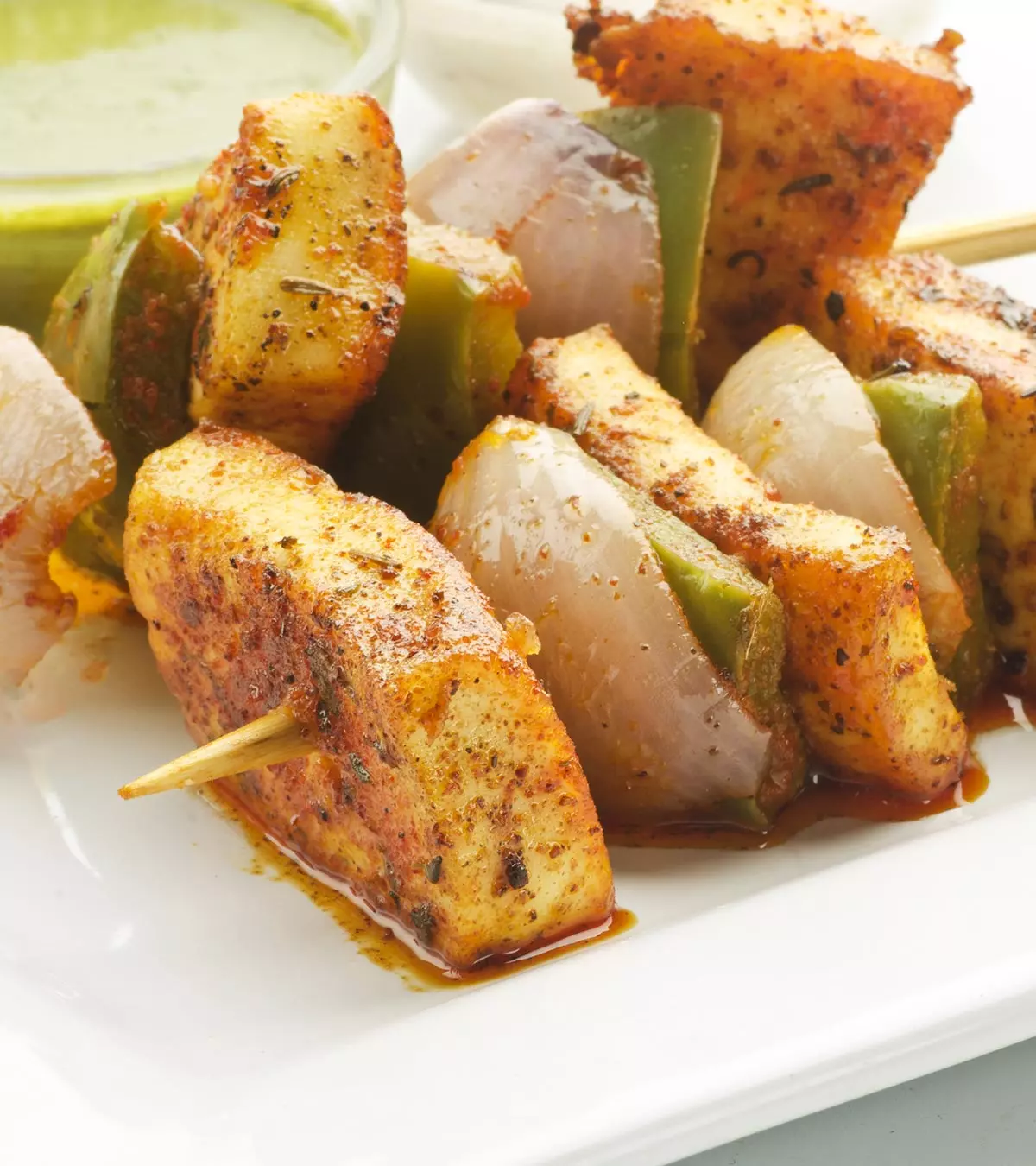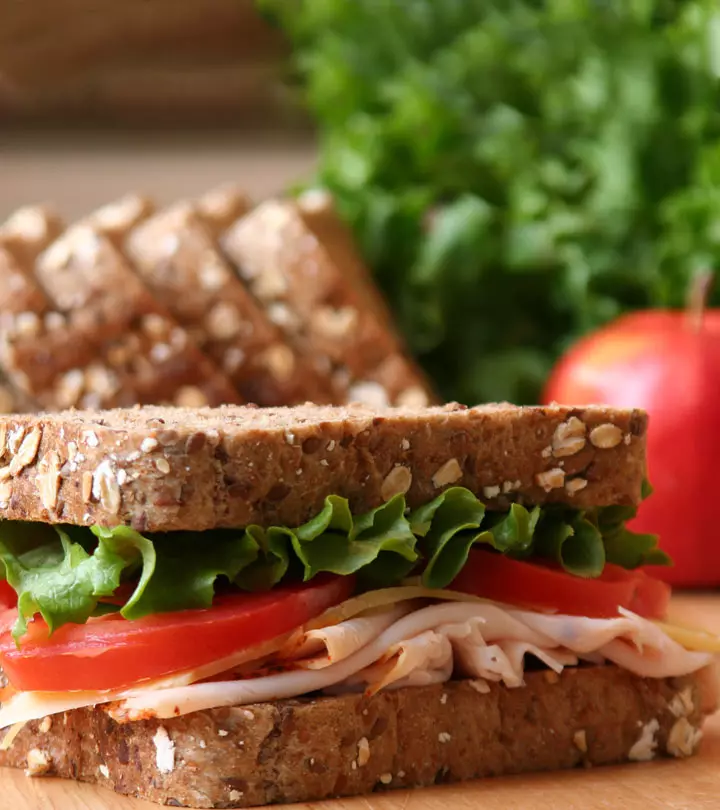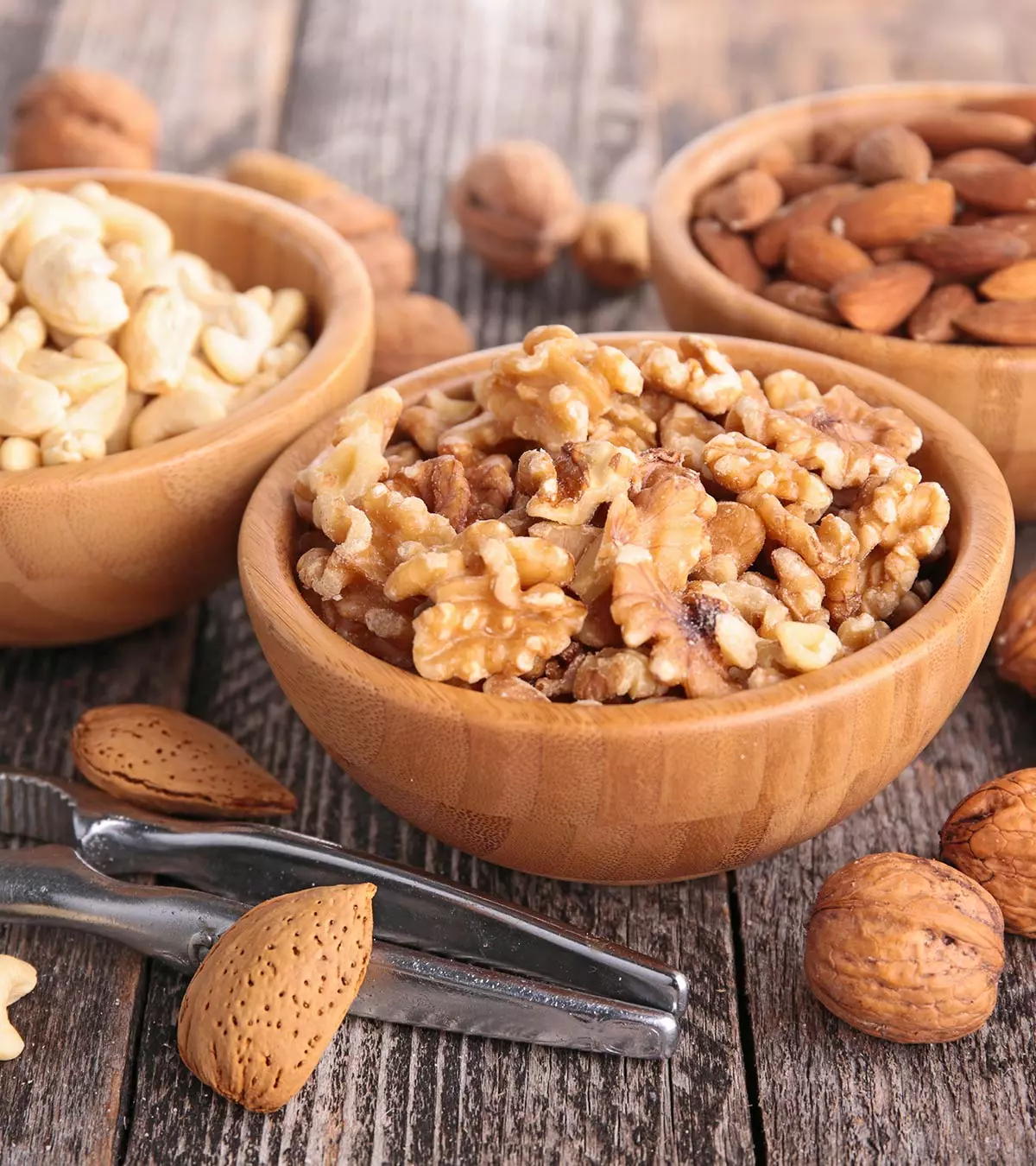
Image: Shutterstock
Dry fruits for kids are the perfect way to provide them with good fatty acids, vitamins, and minerals. The nutritional content of dry fruits aids in the physical and mental development of children.
However, some children may find it difficult to chew dry fruits. In such cases, you can grind them to a fine powder and serve it as is or mixed in a health drink. Additionally, this step would help you avoid any choking hazards.
Read this post to learn more about the health benefits of dry fruits and what nutrients they may add to your child’s diet.
Key Pointers
- Dry fruits that can be added to a children’s diet plan are walnuts, cashews, almonds, and raisins.
- Dry fruits contain several vitamins, healthy fats, and minerals that are crucial for children’s growth and development.
- Almonds and walnuts are especially beneficial, as they are rich in essential fatty acids, fiber, and vitamins that promote brain and heart health.
- Consuming raisins and cashews can also help children develop strong bones.
- Apart from these benefits, dry fruits can help boost children’s digestion, cardiovascular health, prevent anemia, and support overall health.
Different Dry Fruits Beneficial For Your Kid’s Health

Image: IStock
Multiple institutions have conducted a review revealing that adults who consume a healthy amount of nuts have a 24% lower risk of developing coronary heart disease. Although data for children is limited, this noteworthy percentage emphasizes the importance of including nuts in your child’s diet. There are different types of dry fruits available in the market. Some of them taste sweet while some have a nutty flavor. Here are some dry fruits you can safely add to your kid’s meal plans:
- Almonds: The dry fruit is a rich source of dietary fiber, magnesium, iron, and calcium. It contains a high proportion of monounsaturated fats that help to lower the blood cholesterol levels and prevent potential cardiovascular problems. Almonds are also rich in protein and can boost your kid’s growth and development during these crucial years. The healthy nuts will keep your kid’s tummy full and prevent him from snacking on junk food. It will also help to keep the threat of childhood obesity at bay. The vitamin E in these tasty nuts can also give your kid radiant skin (1)
- Raisins: These are essentially the sun-dried form of grapes. The high sugar content and antioxidants in raisins acts as energy boosters and can take care of the energy requirements and hunger pangs of your hyperactive kid. Raisins are a storehouse of minerals like Magnesium, Phosphorus, Potassium, Iron, Copper, and Manganese. Consuming this tangy dry fruit on a regular basis can help prevent anemia and protect your growing kid’s bone health (2).
- Walnuts: The crunchy and delicious dry fruit contains a high proportion of essential omega 3 fatty acids, which help fight LDL and boost the cardiac health of your kid. It also helps prevent metabolic disorders in children. This includes disorders like diabetes and cancer. Walnut termed as ‘brain food’ is helpful in safeguarding the brain development of your kid. It is a must-have for your kid as it is a rich source of Vitamins B1, B2, B6, and folic acid. It also contains minerals like manganese, copper, magnesium, zinc, phosphorus, iron, calcium, and potassium (3).
- Cashews: These delicious nuts are replete with essential nutrients like manganese, copper, magnesium, zinc, and phosphorus. Adding it to your kid’s diet will ensure he has strong and healthy bones.
 Quick fact
Quick factHealth Benefits Of Dry Fruits For Kids
Eating nuts can boost your kid’s health in the following ways:
- Aids Digestion: Dry fruits are fiber-rich foods for kids. Consuming it can boost your kid’s digestion. It can help to regulate his bowel movement, fight constipation and end his toilet ordeal every morning.

Image: IStock
- Protects Cardiovascular Health: Adding dry fruits to your kid’s daily breakfast menu is a tasty way to boost his heart health. The crunchy nuts are rich in healthy fats and help to fight bad cholesterol. Most dry fruits are also a rich source of potassium that helps keep blood pressure in check and prevent stroke.
- Prevents Anemia: Dry fruits are an important source of iron. A healthy portion size of homemade trail mix of organic dried fruits is a wonderful snack idea that can boost your kid’s hemoglobin levels. It will help in keeping the threat of anemia at bay and let your kid enjoy good health and development.
- Maintains Healthy Bones: Munching on nuts can provide your kid his daily dose of essential minerals like magnesium and phosphorus. Both these nutrients play a vital role in maintaining their bone density, boosting dental health and protecting him from osteoporosis.
Recipes With Dry Fruits For Kids
Try making these easy yet amazing and delicious recipes with dry fruits for your children and watch them savor the goodness.
1. Dry fruits milkshake

Image: IStock
You Will Need:
- 2tbsp pistachios
- 10 almonds (peeled)
- 10 cashews
- 2 dried figs
- 3 dates
- ½ or ¼ tsp cardamom powder
- 2 ¼ cups milk, or more, if needed
- 1tbsp dry fruit powder
How To Prepare:
- Soak the dry fruits in water for about 45 – 60 minutes
- Drain the water and add the fruits into a blender along with cardamom powder and chopped dates.
- Add one cup of milk and blend well. If needed, you may add more milk to achieve the desired consistency of the milkshake.
- Pour into glasses and top it off with dry fruit powder.
- Serve immediately or chilled.
2. Chocolate and dry fruit fudge
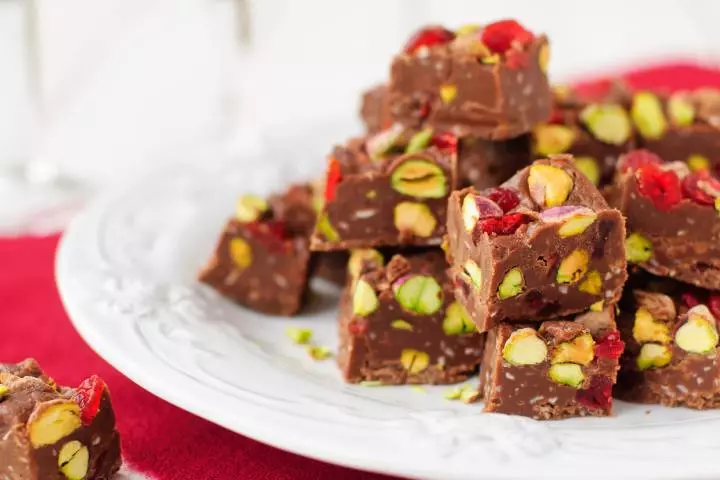
Image: Shutterstock
You Will Need:
- 1 ½ cup condensed milk
- 1 ½ cup melted dark chocolate
- 2 tbsp melted butter
- 1 tbsp black and green raisins
- 3 tbsp cashews
- 3 tbsp chopped walnuts
- 2 tbsp pistachios
- 3 tbsp almonds
- 1 tbsp cranberries
- ¼ cup chopped mixed dried fruits
How To Prepare:
1. In a bowl, add the dark chocolate, condensed milk, melted butter, and stir to mix it until it becomes a thick paste.
2. Add the almonds, cashew nuts, pistachios, walnuts, raisins, black raisins, and cranberries to the chocolate mixture and mix well.
3. Transfer this chocolate and dry fruit mixture into a baking dish lined with baking paper and spread it eventually with the help of a spatula.
4. You may decorate the top of the mixture with slivers of dry fruits
5. Put this mixture in the fridge for about one hour or until it sets.
6. Once chilled, cut the fudge into square pieces and serve chilled.
3. Nutty Trail Mix Recipe
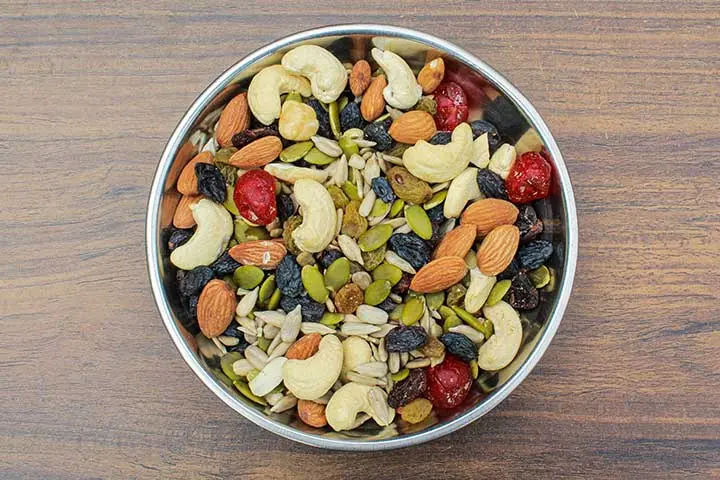
Image: Shutterstock
You Will Need:
- 1 ½ cups raw nuts (almonds, cashews, peanuts, etc.)
- 1 cup raw seeds (sunflower seeds, pumpkin seeds, etc.)
- 1 cup dried fruits
- Fun additions (chocolate chips, coconut flakes, etc.)
- ¼ tsp sea salt
- ½ tsp cinnamon
- Pinch of nutmeg (optional)
How To Prepare:
- In a large mixing bowl, combine the raw nuts and seeds.
- Add the dried fruit and any fun additions you’d like to include.
- Sprinkle in the sea salt, cinnamon, and nutmeg.
- Stir everything together until well mixed.
- Store in an airtight container and enjoy a quick snack!
 Quick tip
Quick tip
Image: IStock
Frequently Asked Questions
1. How much dry fruit should kids eat?
Children should eat 1/4th cup of dry fruits daily and other fruits and their daily nutrition (4).
2. When can kids eat nuts?
Children can start eating nuts when they start their solid food diet at six months in grounded or paste form to prevent choking (5).
3. How should dry fruits be stored to maintain their freshness and nutrition?
Dry fruits need to be stored in an airtight container and kept in a cool, dark, and dry place to retain their freshness and prevent moisture and insects. It is also essential to consume them within a year to get maximum nutrition and benefits (7).
4. How can children with specific dietary requirements, such as vegan or gluten-free, still enjoy dry fruits?
Anecdotal sources indicate that dry fruits can be included in vegan and gluten-free diets for children. They may be included in chopped, powdered, or pureed form with porridges, breakfast cereals, salads, and other child-friendly foods.
5. How can I introduce dry fruits to a picky eater?
A picky eater needs a gradual introduction to tastes. You may begin by including dry fruits in powder or puree form into porridge, yogurt, smoothies, and soups. You may later modify their intake by gradually adding chopped pieces to breakfast cereals, sandwiches, salads, and trail mixes. With time, the child may begin consuming whole dry fruits and nuts once they have adapted to the flavor.
Dry fruits are considered among the most nutritious and healthy foods for kids. They make a healthy, food option for children. Regular consumption of dry fruits could benefit your child, from maintaining heart health, bone health, brain development to preventing anemia and acting as a support to the immune system. You can allow your children to munch on various dry fruits such as almonds, raisins, and walnuts, and you may try making different recipes so they can eat them without a second thought. Make sure your child is not prone to nut allergies before feeding them dry fruits and nuts.
Infographic: How Does Eating Dry Fruits Benefit Children?
Along with being a great alternative to sugary snacks, a handful of almonds, dates, and other dry fruits can be a yummy and quick snack for children. Also, the nutrient-rich profile of various dry fruits offers several health benefits to children. Read through the infographic below to learn about some benefits of dry fruits for children.

Illustration: Momjunction Design Team
Illustration: Amazing Health Benefits Of Dry Fruits For Kids

Image: Stable Diffusion/MomJunction Design Team
References
- Benefits of almonds.
https://www.canr.msu.edu/news/benefits_of_almonds - J Higgs, E Derbyshire, and K Styles; Nutrition and osteoporosis prevention for the orthopaedic surgeon.
https://www.ncbi.nlm.nih.gov/pmc/articles/PMC5508855/ - Shibu M Poulose et al.; (2014); Role of walnuts in maintaining brain health with age.
https://pubmed.ncbi.nlm.nih.gov/24500933/ - Fruits and vegetables.
https://www.foodandfun.org/resources/pdf/tips/fruitveg.pdf - Nuts, health and kids.
https://nutritionaustralia.org/fact-sheets/nuts-health-and-kids/ - Are figs good for you? Get the whole sweet story.
https://www.heart.org/en/news/2021/08/05/are-figs-good-for-you-get-the-whole-sweet-story - Drying Fruits – 9.309 https://extension.colostate.edu/topic-areas/nutrition-food-safety-health/drying-fruits-9-309/
Community Experiences
Join the conversation and become a part of our nurturing community! Share your stories, experiences, and insights to connect with fellow parents.
Read full bio of Dr. Prakhar Nyati
Read full bio of Sindusha MS
Read full bio of Swati Patwal
Read full bio of Shinta Liz Sunny













